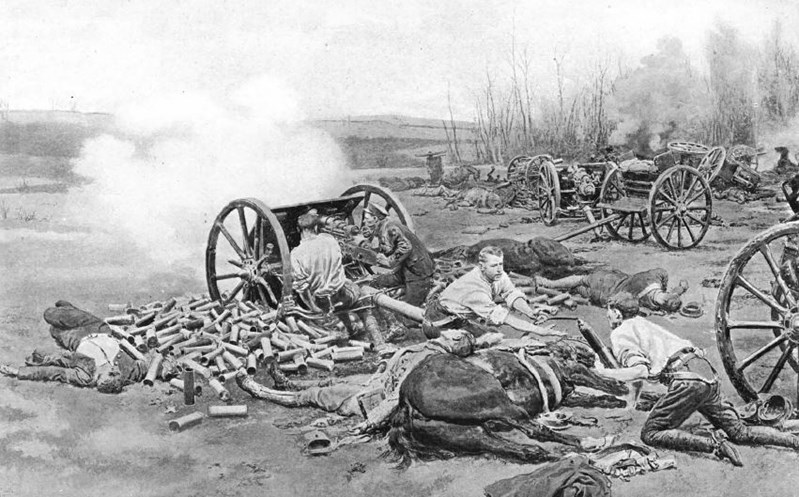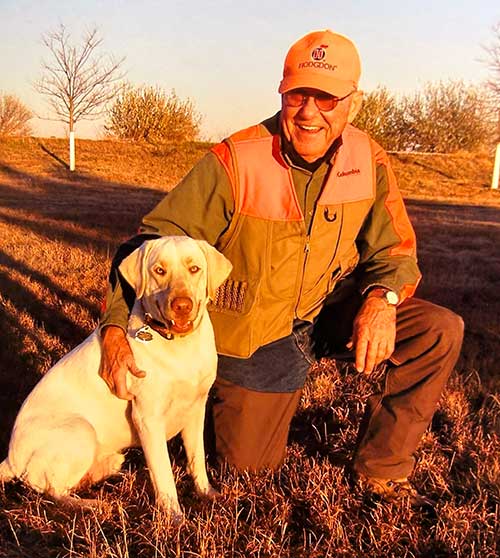Category: Real men
You cannot make this up, and even if you could, the actual facts would read like something out of a really strange movie script about good versus just plain dumb.
When Illinois Gov. J.B. Pritzker last month rushed to sign a brand new gun control bill before the Legislature adjourned (only to re-convene about 24 hours later), something happened nobody saw coming. County sheriffs up and down the Prairie State loudly declared they would not enforce the new law, which banned so-called “assault weapons” and “high-capacity magazines.” It requires current owners to register their guns with the Illinois State Police.
How this may play out is ripe for speculation. By the time you read this, at least one federal lawsuit involving the Illinois State Rifle Association, Second Amendment Foundation and Firearms Policy Coalition will have been filed. There could be more. It all means that the new Illinois law might be headed for a collision with the Constitution’s Second Amendment.
This certainly appears to be what the sheriffs of at least 80 Illinois counties were thinking when they posted letters saying essentially the same thing.
“As your duly elected Sheriff,” the letter says, “my job and my office are sworn to protect the citizens … This is a job and responsibility that I take with the utmost seriousness. The right to keep and bear arms for defense of life, liberty and property is regarded as an inalienable right by the people of this country …”
“Therefore, as the custodian of the jail and chief law enforcement official, I proclaim that neither myself nor my office will be checking to ensure that lawful gun owners register their weapons with the State, nor will we be arresting or housing law-abiding gun individuals that have been arrested solely with non-compliance of this Act.”
Published reports, and reliable sources, confirm Pritzker was furious when the sheriffs went public with their opposition. When he intimated the lawmen would lose their jobs, at least two different Illinois sources told me between laughs that the governor does not have the authority to fire elected sheriffs.
Meanwhile, Out West
When sheriffs in Washington State got wind of the gun control package put forth by Gov. Jay Inslee, which also involves a ban on semi-auto rifles, the Washington State Sheriff’s Association circulated a letter signed by Kittitas County Sheriff Clay Myer —president of the group — and it was not congenial.
“Governor Inslee,” Sheriff Myers wrote, “has announced plans for significant new restrictions on the ownership of firearms by law-abiding Washingtonians. We, members of the Washington Sheriffs’ Association, believe the proposed restrictions will serve to erode constitutionally protected rights without addressing the root causes of violent crime. We are particularly concerned with the proposed so-called ‘assault weapons ban’ and ‘permit to purchase’ laws.”
A few paragraphs later, Myers put it bluntly: “The rise in violent crime that so concerns citizens has happened even as regulations and restrictions on firearm ownership have grown. Of course, this is because the people who commit violent crimes simply don’t concern themselves with obeying rules about guns.”
Murder and mayhem is up in Washington, and so is the number of concealed pistol licenses. As the year wrapped up, there were just short of 697,000 active CPLs in circulation, according to data from the state department of licensing.
It’s not the first time county sheriffs have “just said no.” Back in 2018 and early 2019, many Washington sheriffs announced they would not actively enforce provisions of Initiative 1639, an extremist gun control measure passed by voters.
Some sheriffs in New York State say they will not “aggressively” enforce that state’s new gun law, which is being challenged by at least two federal lawsuits. A few sheriffs in Oregon have said essentially the same thing about provisions of Measure 114, the gun control initiative passed there last November.
A Good Man Gone
The problem with being an old gun guy is that it becomes more frequent we must say “goodbye” to a good friend, who happens to have also been just a plain good person.
Robert E. “Bob” Hodgdon, whose family name is part of the fabric of American metallic cartridge reloading, passed away Jan. 13. Having been born in August 1938, Hodgdon had a good run that covered a lot of ground. He and his brother, J.B. helped build the company founded by their father, Bruce Hodgdon, and today that name is iconic in the industry for the variety of reloading propellants for rifles, shotguns and handguns. According to an obituary the family posted, he “also assisted with the design and lead the team constructing the Pyrodex Plant in Herington, Kan. in 1979 and helped to design and build The Bullet Hole, a 44-station indoor shooting range in 1967.”
I served with Hodgdon on the NRA board of directors more than 20 years ago, and you could not find a more devoted fellow where perpetuation of the shooting sports, and protection of the Second Amendment, was concerned. He was a kind and gentle soul, a person you’d be delighted to share a campfire with, and someone who was as devoted to his family as his professional pursuits. He was father to four children, Chris (Adele) Hodgdon, Heidi (Erwin) Rodriguez, Stacie (Bryant Larimore) Hodgdon and Alisa Hodgdon — and grandfather of 11 and great-grandfather to eight.
A native of Kansas, he grew up in suburban Kansas City. He attended Baker University in Baldwin City, Kan., and graduated Summa Cum Laude from the University of Kansas. He served in the U.S. Air Force and the Air Force Reserves.
He served as president of Hodgdon for more than 20 years and then as board chairman from 2014 to 2017.
Hodgdon volunteered in several civic organizations, and was a member of the Westside Family Church in Lenexa, Kan.
Additionally, he was a founding member of the National Shooting Sports Foundation, a member of the Kansas State Rifle Association, and founding member of the Kansas Sportsmen’s Alliance.
Men like Bob Hodgdon are very rare.

Some Red Hot Gospel there!

Me too!


Some WWI British Studs!

L Battery R.H.A. “How our Gunners Won the V.C. and Silenced the Fire of the German Guns in the Face of Overwhelming Odds.” Print by Fortunino Matania. From Deeds that Thrill the Empire (published 1919).
The Affair of Néry was a skirmish fought on 1 September 1914 between the British Army and the German Army, part of the Great Retreat from Mons during the early stages of the First World War. A British cavalry brigade preparing to leave their overnight bivouac were attacked by a German cavalry division of about twice their strength, shortly after dawn. Both sides fought dismounted; the British artillery was mostly put out of action in the first few minutes but a gun of L Battery, Royal Horse Artillery kept up a steady fire for two and a half hours, against a full battery of German artillery. British reinforcements arrived at around 8:00 a.m., counter-attacked the Germans and forced them to retreat; the German division was routed and did not return to combat for several days. Three men of L Battery were awarded the Victoria Cross for their part in the battle, the battery was later awarded the honour title of “Néry”, the only British Army unit to have this as a battle honour.

Some people are just born cursed. While there are those whose lives seem inexplicably blessed with prosperity, comfort, and peace, others can be destined for squalor, chaos, and pain. Call it karma, luck, providence, or fate, it is tough to comprehend from our limited perspective why life is the way it is.

Why do some reprehensible people die in their late 80’s after a long life of debauchery and self-abuse while some saint succumbs in their teens to cancer? In medicine, you sometimes get fatalistic about it. The sweet little grandmother strikes her head and strokes out, while the unkillable thug catches half a dozen rounds in a drug deal gone bad and leaves the hospital under his own steam the next day. Someday God will explain such stuff to me face-to-face in a way I will understand. Until then, I haven’t a clue.
A Most Unusual Tale

In the peculiarly tragic life of Yang Kyoungjong, we see the curious power of fate at work. According to an interview by the esteemed historian Stephen Ambrose, there were at least four ethnic Asians captured by American forces in the opening days of the D-Day invasion. These troops purportedly did not speak German and were wearing Wehrmacht uniforms. One of these men has been identified as a Korean named Yang Kyoungjong.

Before we proceed, appreciate that there is controversy surrounding this story. It was related as fact for years and was even used in an online advertisement for a real estate company in St. John’s, Newfoundland. In 2011 Yang’s story formed the basis for a South Korean movie titled My Way. However, documentary filmmakers in Korea have researched the story and subsequently cast some doubt on its veracity. Regardless, the narrative is nonetheless both compelling and plausible. Try to just enjoy the ride.

Born in Korea on March 3, 1920, Yang was a conscript in the Kwantung Army in Manchuria. Operating between 1919 and 1945, the Kwantung Army was the most prestigious command in the IJA (Imperial Japanese Army). While the Kwantung Army saw a great many battlefield successes, they were also responsible for some of the war’s most egregious atrocities. Among these was the infamous Unit 731 which performed biological warfare experiments on both captured civilians and prisoners of war.

Manpower was always a critical component of any WW2 military campaign. The United States enjoyed vast resources of both men and raw materials for military production. The British drew from across the Commonwealth. The Germans, Japanese, and Russians harvested meat wherever it could be found and threw a uniform on it. This resulted in some peculiar loyalties.

Yang Kyoungjong was first press-ganged into service in 1938 at age 18. The following year he was captured by Red Army troops during the Battle of Khalkhin-Gol and remanded to a forced labor camp. By 1942 the Soviet Union was in dire straits and faced the very real probability of national extinction at the hands of the Nazis. This drove Russian commanders to some desperate places.

When you’re packed into a prison camp alongside several thousand of your mates subsisting on sawdust bread and whatever rats you can catch, most anything seems like an improvement. When the desperate Russians came looking for cannon fodder, Yang either volunteered or didn’t resist unduly. Either way, he soon found himself in a Soviet greatcoat fighting under the red banner for Mother Russia and Marxism.

In 1943, Yang found himself in Ukraine at the Battle of Kharkov. The Battle of Kharkov was actually four distinct battles spanning nearly two years. The first began in October of 1941 when the Germans captured the city. The last took place in late summer 1943 when the Soviets finally won it back for good. It was the Third Battle of Kharkov in February of 1943 that saw Yang captured by the Germans.

By now the tide was turning against the Nazis, and they were beginning to sense the mess they had gotten themselves into. With war raging on three fronts, the German High Command began harvesting the dregs for manpower. Where previously service in the Wehrmacht and Waffen SS might have been a prestigious thing that was both selective and competitive, by this point in the war if you could stand and hold a rifle you met the entrance standards. As a result, Yang Kyoungjong found himself wearing field gray in an Ost-Bataillone.

These scratch units went by several titles. Osttruppen, Osteinheiten, and Ostlegionen all meant similar things. With piles of bored and starving Soviet conscripts languishing in prison camps, the Germans enlisted those they felt might be ideologically malleable into these ad hoc support units. Results were predictably mixed.
Absolute Power Corrupts Absolutely

Josef Stalin was a turd. He was a relatively small man at 5 foot 5 inches tall. He was also ugly. A severe bout with smallpox as a child left him badly scarred. Stalin was directly responsible for the deaths of between 20 and 40 million people. This makes Josef Stalin one of the most prolific mass murderers in human history.

Stalin ruthlessly enforced a weird sense of justice. To be captured by the enemy in battle was frequently viewed as being tantamount to cowardice or even treason. A great many captured Soviet soldiers faced harsh imprisonment or execution upon repatriation. As a result, while most soldiers like Yang had little use for Naziism, they did find service in an Ost-bataillone preferable to the alternative.

Ost-Bataillones were battalion-sized units comprised of a mixture of volunteers and conscripts who were most typically posted in support roles away from the front-line fighting. This allowed the Germans to use their own troops for more serious work. The Ostlegionen were larger formations that were usually ethnically similar and comprised of multiple battalions. One of the roles for which the Germans used these foreign units was as defensive troops in fixed fortifications in fairly quiet places. In early June 1944, that is what brought Yang Kyoungjong to the placid beaches of Normandy, France.
Capture

Operation Overlord was the most extensive amphibious invasion in human history. Given advances in intelligence, logistics, and military technology it is highly unlikely that this performance will ever be repeated on such a grandiose scale. One of the more revolutionary aspects of the invasion was the widespread use of airborne forces.

The Germans really pioneered the widespread use of paratroops. The airborne assault on Crete in 1941 was ultimately successful but only at a fearsome cost. Hitler refused to authorize any further large-scale use of parachute forces in their intended role as a result. German fallschirmjagers were subsequently used as elite light infantry for the rest of the war. The Allies, however, aggressively developed the concept of airborne vertical envelopment.

Most of the 13,000 Allied paratroopers dropped on D-Day did not accomplish their specific assigned tactical objectives. Intense ground fire and chaos among the lift aircraft ensured that units were spread randomly and piecemeal across the Norman countryside. However, once these aggressive, highly-trained airborne warriors touched down they proceeded to sow chaos among German combat and support units wherever they found them.

One of these American paratroopers was LT Robert Brewer of the 506th Parachute Infantry Regiment, 101st Airborne Division. According to the Stephen Ambrose interview, Yang was one of four Asians in Wehrmacht uniforms LT Brewer and his men captured in the immediate aftermath of the D-Day invasion. At the time it was presumed that the four were Japanese. It was later determined that Yang’s three companions were from Turkestan. Yang was processed and sent across the channel to a POW camp in Britain. From there he was further removed to a camp in the US.
The American Dream

The American South was dotted with such camps during and immediately after the war. My family and I lived in Clinton, Mississippi, while I was in medical school. The POW camp outside Clinton had long since been transformed into a sweeping grassy park, but it still retained fields of daffodils planted and cultivated by the 3,000 German and Italian POWs who were held there during the war. Most of the Clinton prisoners were members of the Afrika Korps captured in North Africa early in the war. There is a small contingent of graves in the Jackson, Mississippi, cemetery occupied by German troops who perished in captivity.

Yang Kyoungjong was finally released from captivity in 1947. After such a violent and circuitous trek across all those Asian and European battlefields, Yang was purportedly none too keen to return to the nation of his birth. By the time of his release, he had already been away from home for nearly a decade.

Yang purportedly opted to remain in the United States after his release. He is said to have settled in Evanston, Illinois. He died there in April of 1992 at the age of 72.
Ruminations

It is easy to lose the trees for the forest when it comes to the study of war. I have a rabid addiction to military history books myself. My home sags under the weight of such. This is where I find much of the inspiration for our efforts here. My perennial challenge is finding tales of the individual soldier.

Book shops are dirty with tomes about Generals and campaigns. Memoirs about the movement of armies have occupied many a retired General officer in his waning years. However, what fascinates me are the tales of the regular private soldier. The humble dogface is the single entity who does most of the suffering and, in so doing, wins the wars his political leaders craft for him. In the curious tale of Yang Kyoungjong, we find the story of a normal guy caught up in some decidedly abnormal circumstances. I for one hope hope his life was ultimately warm and fulfilling.

